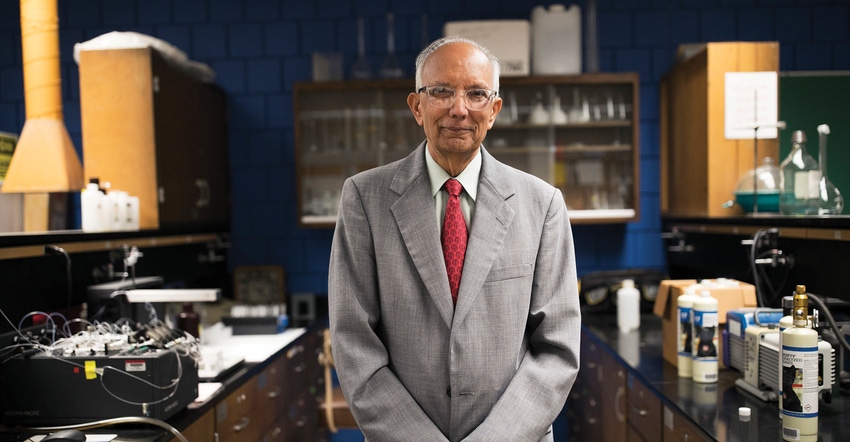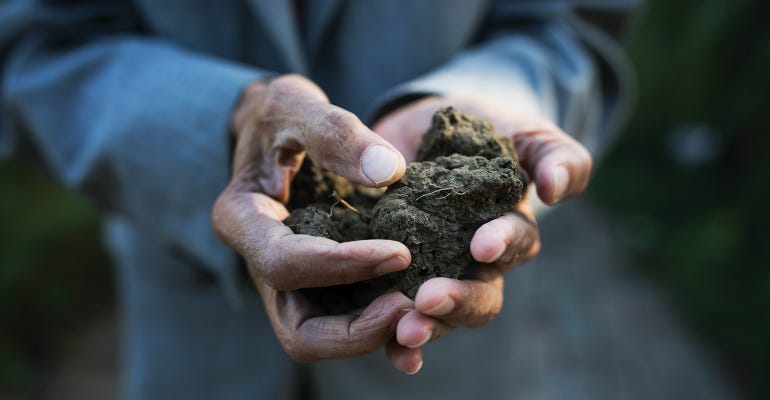
The United States has a Clean Air Act and a Clean Water Act. But renowned soil scientist Rattan Lal says it also needs a Healthy Soil Act if we’re really going to protect the environment and combat climate change.
“We have no healthy soil act, therefore clean water and clean air are pie in the sky if there is no healthy soil,” says Lal, a Distinguished University Professor of soil science at the Ohio State University. “Healthy soil requires organic carbon. There are many benefits that depend on putting carbon back in the soil; mitigating climate change is just one of them.”
Lal believes passionately that farmers can play a key role in fighting climate change. Not only will healthy soil store carbon and keep it out of the atmosphere, but such soil will reduce the need for synthetic fertilizer and pesticide, both of which release additional carbon during production and transport. Also, carbon aids the soil’s crop production abilities by nourishing helpful organisms and retaining water.
So what would this soil health guru do to develop healthy soil? Here are his six key takeaways:
maintain continuous soil cover (mulch, cover crop, residue)
eliminate plowing
reduce vehicular traffic
apply compost or manure
grow a cover crop during the off season
Use chemicals prudently/sparingly and, if possible, by precision methods.
He also advocates the 4R rule for chemical applications—Right Source (the balanced use of nutrients), Right Rate (rate determined by soil tests and crop demand), Right Time (apply only when the crop needs it), and Right Place (precision application such as in the root zone).

Nobel Prize winner
Lal knows what he is talking about. He has won numerous international awards for his studies on soil health and climate change. He was the lead author on the 2007 Nobel-Peace-Prize winning report by the Intergovernmental Panel on Climate Change. Last year he was presented the $100,000 World Agriculture Prize, given by the Global Confederation of Higher Education Associations for Agriculture and Life Sciences. This year he received the Japan Prize worth $450,000.
He donated all the prize money to the Ohio State University.
Many of his studies relate to farming and what farmers can do to improve soil health. Much of his research focuses on accomplishing that via conservation agriculture, crop rotation, and consistently covering soil with cover crops and residue mulch.
His findings promote crop production at lower costs while reducing greenhouse gas emissions that hurt the air and water.
“It will produce better quality food and cheaper because soil carbon will improve the efficiency of inputs,” he says.
Inefficient fertilizer
Lal says crops utilize only 30% of the nitrogen fertilizer applied, with the rest either going into air as nitrous oxide, or washing away into streams and leaching into ground water. To correct this he advises use of alternate sources of fertilizer such as animal manure, other biosolids and recycling nutrients in crop residues, and precision application of fertilizers.
“Nitrous oxide is 310 times more potent in causing global warming than carbon dioxide,” he says. “When you are only using 30% how can you afford to waste 70%? Not only are you wasting, you also are hurting the water and the air.”
Herbicide use is another contributor. Lal says the production, packaging, transportation and application of glyphosate, a key ingredient in popular weed control products, is inefficient. Studies show, he says, that 6 to 8 lbs. of carbon is put into the atmosphere for every pound of glyphosate used.
Lal admits that he is a researcher and has little contact with farmers, but farmers can learn about his research and recommended practices via local farm agents or university extension services.
“Farmers are not dumb, they are very intelligent,” he says. “It is the scientists who are not reaching out to the farmers and policy makers. We need to reach out to them.”
Lal believes there is an urgency to his work. Farmland is on the decline globally while the need for food production is on the increase as population grows. Urbanization and infrastructure development have taken over farmland.
As a result, in research published this summer in the Journal of Soil and Water Conservation, Lal proposed a “Rights-of-Soil,” which could provide a legal means to protect soil from misuse or degradation, much like current laws that protect against air and water pollution, and similar to those that protect endangered species.
Sounds like something that belongs in the ‘Healthy Soil Act,’ promoted by passionate soil advocates like Rattan Lal.
Burgdorfer writes from Lenexa, KS
Read more about:
ClimateAbout the Author(s)
You May Also Like




